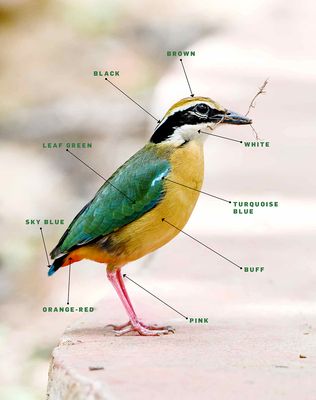The Indian pitta is a shy bird; it is heard more than it is seen. This small migratory bird gives a whistle call in the morning and evening, thus earning its Tamil name aarumani kuruvi (the six-o-clock bird). Those who get a glimpse of it would confirm that its English name does not capture its glory. However, its Hindi name, navrang (the nine-coloured bird), aptly details the bird’s most characteristic feature—its brilliant plumage.
A pair of Indian pitta nest in an abandoned ashram of the Bharat Yatra Trust in Bhondsi near Gurugram—which is now being converted into a nature park by the Haryana government. And, birders have been flocking to the couple’s monsoon home for the last few years. As monsoon set in, the pair would migrate from their summer haunts in south India or Sri Lanka to the Aravalli range.
In the centre of the ashram complex is a popular temple dedicated to Bhuvaneshwari Devi. Mr and Mrs Pitta do not mind either the pilgrims or the battalions of photographers who come with their cameras and ‘bazooka’ lenses. Contrary to the perception about pittas, the Bhondsi couple is camera savvy. They often offer a full display of their nine-coloured plumage when they fluff up after picking something from the ground, or when resting on a perch. The birds have long, strong and pinkish legs, and stout bills. They have buff-brown crowns with black stripes running down the middle. Their eyes have distinct black stripes. The ‘shirtfronts’ are buff and green, and their vents are bright red. Their shoulder patches are blue.
Like a royal couple at a palace window, they seem to pose for the paparazzi who want to capture their private moments. It helps that the couple’s nest is in plain sight. There is a convention in the birding community these days to not post geotagged pictures of nests and eggs, as these may endanger the birds. The more persistent paparazzi are known to tramp quite close to nesting sites, sometimes even damaging nests and eggs.
When the photographers leave, the couple get on with the pending, mundane chores of foraging for food and nesting material. Devendra Singh, additional secretary in the railway ministry, is a regular at the site. Like many others, he is also a visual chronicler of the couple’s monsoon love. “The birds’ calls are mesmerising,” he says. “No dance movement can compete with the poetry of the Pittas’ movements. And they look so tidy and groomed, as if they take a bath every hour.”
The couple stays in the ashram until late August, and raise two or three chicks. Then the new family heads south as the winter mists roll over northern India.


